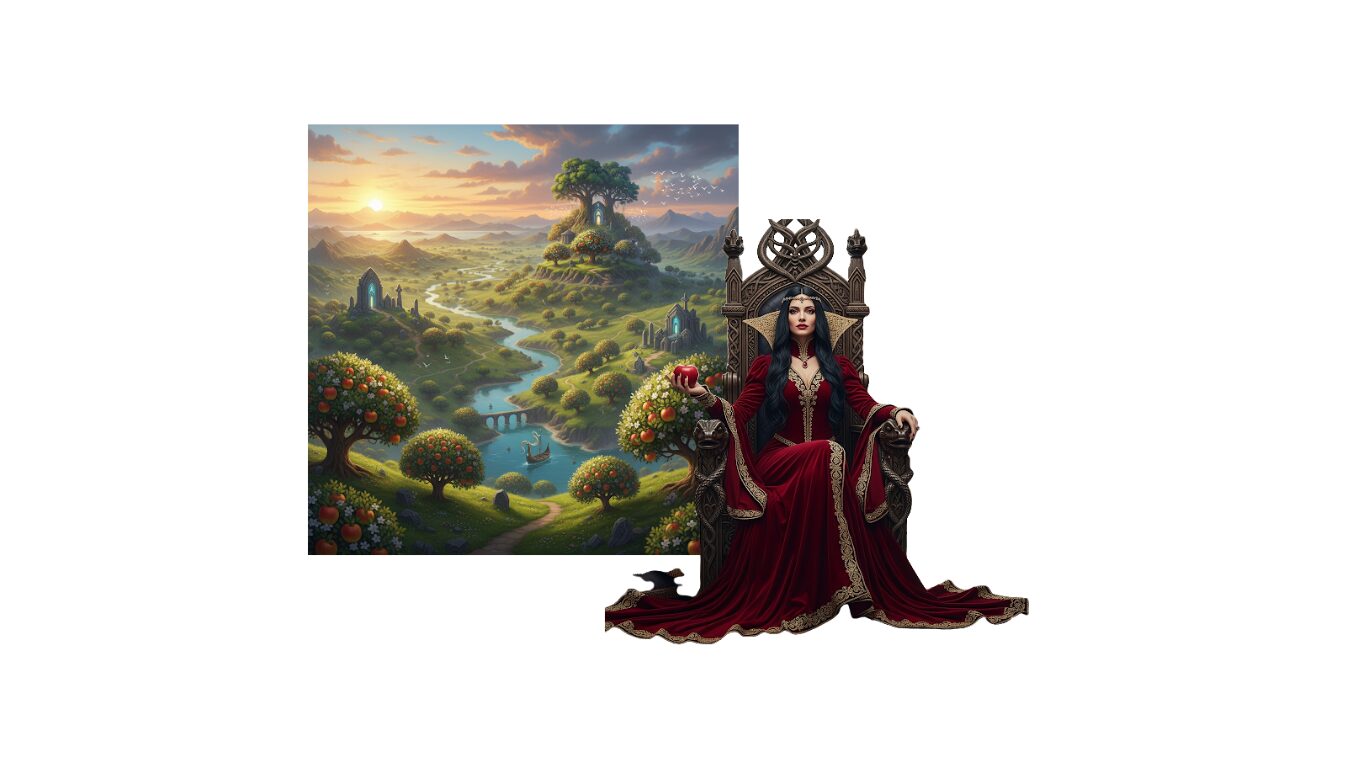Apples are far more than a simple autumn fruit, they carry deep roots in UK folklore and mythology, echoing stories of magic, wisdom, and the veil between worlds.
We all know the fairy tale of Snow White, the poisoned apple given to her by the evil queen. Apples have long carried that double meaning of nourishment and danger, blessing and curse. While we can’t say for certain that the Grimms drew directly from older Celtic or Arthurian tales, the image of the apple runs deep in folklore. What we see in Snow White may well be an echo of those older stories where apples granted youth, knowledge, or passage to the Otherworld.
Avalon and Morgan le Fay

In Celtic and English folklore stories, apples were seen as fruits of the Otherworld. Stories tell of enchanted orchards where the fruit offered eternal youth, healing, and wisdom. The most famous of these is Avalon, the Isle of Apples, where King Arthur was taken to be healed after his final battle. To eat an apple from such an orchard was to cross the threshold into another realm, even if only for a moment. The name ‘Avalon’ is believed to have been derived from the old Celtic word for apple (afal in Welsh).
It is Geoffrey of Monmouth who first names Avalon as the place where the mortally wounded King Arthur is taken in his text, Historia Regum Britanniae. Geoffrey describes it as a paradise of self-sowing orchards and endless fertility—an “Isle of Apples”.
In Avalon resides the legendary Morgan le Fay, introduced in Geoffrey’s account as Morgen, the most skilled of nine magical sisters who rule Avalon. Morgan is both healer and enchantress, tending Arthur’s wounds and presiding over a land where abundance never wanes. The apple orchards of Avalon mirror those found in older myths of otherworldly isles, where fruit leads to healing and renewal. In Morgan’s hands, the apple becomes a symbol of knowledge, magic, and the liminal threshold between life and death.
Connla of the Fiery Hair
In Irish lore, apples appear again as gifts from the Otherworld. Connla, the flame-haired son of King Conn, once met a fairy woman who placed an apple in his hand. No matter how many bites he took, the fruit was made whole again. For a month, he lived on nothing else, each mouthful only deepening his hunger for her return.
When she came back, she called him into her boat and carried him to her world, a land where apple trees bent heavily with fruit that granted eternal youth. But like many gifts of the fae, it came at a price. Connla could never return home.
The Apple Tree Man
In Somerset folklore, the apple tree itself was thought to have a spirit known as the Apple Tree Man. He was considered the guardian of the orchard, the soul of the oldest apple tree, and the keeper of its fertility and fortune. Offerings of cider or bread were sometimes poured out beneath the roots to keep him content, ensuring a good harvest the following year. To neglect him risked losing the orchard’s bounty altogether.
Apples and the Fairy Folk
The apple also belongs to the fairy folk. To eat a faerie’s apple was to risk being drawn into their world, yet to leave an apple as an offering was a respectful gesture that kept them friendly. If I am visiting somewhere connected to fairies, I generally try and take an apple as an offering, and when harvesting our apples from the garden, I make sure to leave a few; it is always better to stay on the right side of the fairyfolk!

Apples in Witchcraft and Hedgecraft
- Divination: The five-pointed star revealed at the apple’s core echoes the pentacle, making it a powerful fruit for scrying or Samhain rituals. Apple peelings tossed over the shoulder were said to fall in the shape of a future lover’s initial.
- Healing: Apple blossoms and fruit have long been used in folk remedies for the heart and spirit.
- Protection: Dried apple slices or branches can be placed on an altar or hung in the home to guard against misfortune.
- Cycle Work: Apples embody the turning year, harvest, death, and renewal. They remind us that endings are always bound to beginnings.
In wider witchcraft, apples often appear in spells for love, abundance, and blessing. Hollowed apples filled with herbs or candles become charms, while cider itself can be used as an offering in ritual.

Celtic Myth & Magick: Harness the Power of the Gods & Goddesses by Edain McCoy
Pagan Portals – Living Fairy: Fairy Witchcraft and Star Worship – Morgan Daimler
Pagan Portals – Fairy Witchcraft: A Neopagan’s Guide to the Celtic Fairy Faith – Morgan Daimler
I highly recommend reading any of the Pagan Portal Books. There are so many topics. I will slowly list the ones I have read. The good thing about them is that they are informative but not too long.
